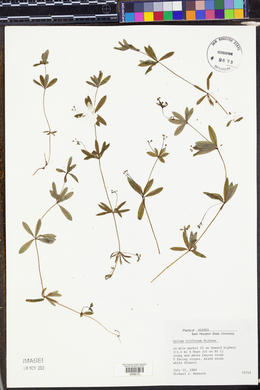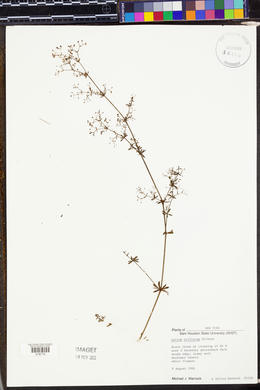Galium triflorum
|
|
|
|
Family: Rubiaceae
Fragrant Bedstraw, more...sweet bedstraw, sweetscented bedstraw
[Galium brachiatum Pursh, moreGalium pennsylvanicum W. Bart., Galium triflorum f. rollandii Vict., Galium triflorum var. asprelliforme Fern., Galium triflorum var. viridiflorum Dc.] |
Plant: perennial herb; glabrous or minutely scabrous on veins and margins; STEMS 20-45 cm long, commonly decumbent and radiating from a center, or sometimes supported by other plants Leaves: 6 per node, 6-38 mm long, usually in horizontal plane regardless of stem position, elliptic to ovate-obovate, narrowed gradually at base, abruptly toward apiculate or mucronate apices Flowers: perfect, (1-)2-3(-5) in pedicellate cymules, on axillary peduncles 2.5-4 cm long; corollas rotate, about as long as ovaries, cream-colored Fruit: FRUITS densely covered with soft white or brownish uncinate hairs as long as fruit body; mericarps brain-shaped Misc: Creeping on damp or shaded forest floors, or semi-erect near streams; 1400-3050 m (4600-10000 ft); May-Sep REFERENCES: Dempster, Lauramay T. 1995. Rubiaceae. J. Ariz. - Nev. Sci. 29(l): 29. Perennial herb with a creeping rhizome 20 cm - 0.8 m tall Stem: weak, scrambling or prostrate, slender, four-angled, unbranched or remotely branched, sometimes bearing some rough, hooked hairs on the angles below. Leaves: mostly in whorls of six (four on smaller branches), 1.5 - 5 cm long, narrowly elliptic to reverse lance-shaped with a bristly tip, one-veined, usually rough-hairy along the margins and rough-hooked on the midrib beneath, thin, vanilla-scented. Inflorescence: a small, branched cluster of three flowers. Flowers: stalked, greenish white, 2 - 3 mm wide, more or less flat and circular in outline, with four short lobes. Stamens four, shorter than corolla. Styles two, short. Fruit: dry, indehiscent, 1.5 - 2 mm wide, spherical, paired, separating when ripe, one-seeded, with hooked bristles. Similar species: No information at this time. Flowering: June to late August Habitat and ecology: Common in moist woodlands, and frequently found on gentle slopes near bogs. Also found in parts of the bogs themselves. Occasional in calcareous springy areas. Occurence in the Chicago region: native Etymology: Galium comes from the Greek word gala, meaning milk, referring to the plants that are used to curdle milk. Triflorum means three-flowered. Author: The Morton Arboretum Dempster 1995, Kearney and Peebles 1969 Duration: Perennial Nativity: Native Lifeform: Forb/Herb General: Perennial forb to vine, glabrous or minutely scabrous on margins and veins, 20-45 cm long, commonly decumbent and radiating from a center, sometimes supported by other plants. Leaves: Whorled, 6 blades per node, 6-38 mm long, usually in horizontal plane regardless of stem position, elliptic to ovate-obovate, narrowed gradually at base, abruptly toward apiculate or mucronate apices. Flowers: Perfect, 2-3 in pedicellate cymes, on axillary peduncles 2.5-4 cm long; rotate corollas, about as long as ovaries, cream-colored. Fruits: Nutlets densely covered with soft white or brownish uncinate hairs as long as fruit body; brain-shaped mericarps. Ecology: Found on damp or shaded forest floors, or semi-erect near streams from 4,500-10,000 ft (1372-3048 m); flowers May-September. Notes: The generally three-flowers help to distinguish this species; can be distinguished from G. aparine by its perennial but herbaceous growth form, and the narrowly to broadly ovate leaves. Ethnobotany: Taken for gallstones, as a love medicine, for backaches, for swollen testicles, rubbed on the skin for chest pains, used to clean up kidney troubles, as a perfume, and a hair wash. Etymology: Galium is from the Greek word gala, milk, an allusion to the fact some species are used to curdle milk, while triflorum means three-flowered. Synonyms: Galium brachiatum, G. pennsylvanicum, G. triflorum var. asprelliforme, G. triflorum var. viridiflorum Editor: SBuckley, 2010 Perennial; stems 2-8 dm, prostrate or scrambling, usually retrorsely hooked-scabrous on the angles at least below; lvs vanilla-scented, mostly in 6's, or only 4 on the smaller branches, narrowly elliptic to oblanceolate, cuspidate, 1.5-5 cm, 1-nerved, generally antrorsely scabro-ciliate on the margins and retrorsely hooked-scabrous on the midrib beneath, otherwise mostly glabrous; infls axillary or also terminal, the peduncles simple and 3-fld to repeatedly branched; fls greenish-white, 2-3 mm wide; fr 1.5-2 mm, uncinate-bristly; 2n=44, 66. Woods; circumboreal, s. in Amer. to Fla. and Mex. June- Aug. Southeastern plants, occasionally extending n. to our range, have reduced upper lvs and branching peduncles, forming a diffuse infl, and have been segregated as var. asprelliforme Fernald, but are not well set off from the more northern phase, common in our range (var. triflorum) with merely 3-fld axillary peduncles. Gleason, Henry A. & Cronquist, Arthur J. 1991. Manual of vascular plants of northeastern United States and adjacent Canada. lxxv + 910 pp. ©The New York Botanical Garden. All rights reserved. Used by permission. From Flora of Indiana (1940) by Charles C. Deam Frequent in moist woods throughout the state. ...... Indiana Coefficient of Conservatism: C = 5 Wetland Indicator Status: FACU |




































































































